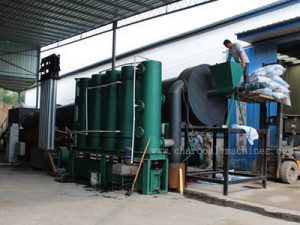Forno contínuo de carbonização, quando a casca de coco é carbonizada, ela deve primeiro ser triturada e moída até certo ponto. Isso pode ser determinado de acordo com as necessidades do cliente. O próximo passo é a secagem. A secagem também é muito importante. A matéria-prima carbonizada geral é carbonizada. Quando estiver seca, caso contrário, o efeito da carbonização não é bom. O grau de secagem da casca de coco é de cerca de 15%-20% de água, não deve estar muito seca. Após a secagem, ela é carbonizada. Isso também é muito importante. Se a carbonização não for bem controlada, ela pode ser descartada, transformada em cinzas ou não carbonizada. Neste momento, o uso do forno de carbonização é muito importante. Como operá-lo? Há vários pontos a serem observados.
1 A alimentação da máquina de alimentação deve ser realizada de acordo com a entrada de material da máquina de carbonização. A condição de queda inicia e fecha a máquina de alimentação para reabastecer o material carbonizado. O material da porta de alimentação inferior também não pode se acumular muito. Recomenda-se que o material no tubo de carbonização seja mantido em cerca de 2/3.
2 A velocidade da máquina de carbonização deve ser ajustada de acordo com o efeito de carbono, e a velocidade do eixo principal deve ser devidamente ajustada para garantir o rendimento de carbono. (A velocidade do eixo principal pode ser ajustada)
3 Quando houver transbordamento de fumaça no assento do eixo em ambas as extremidades do eixo rotativo, o parafuso da prensa da gaxeta de vedação deve ser apertado a tempo após o turno, e a tira de enchimento de amianto do material de vedação deve ser substituída, se necessário.


Sabendo como operar, o próximo passo é o controle da temperatura. O queimador do queimador é pulverizado, o tubo de carbonização é aquecido, o termopar é estendido no corpo do forno, e o espaço dentro do forno é exibido no instrumento de controle de temperatura no painel do gabinete de controle através do fio. temperatura. (A temperatura real dentro do tubo de carbonização será 200~300° mais alta que a temperatura medida no forno.) Equipamento de carbonização ecologicamente correto, aquecido no forno por 15-20 minutos. Quando a temperatura atingir 550-600 graus, pressione o botão de partida da máquina de carregamento, o parafuso na máquina de rosca gira, e a alimentação da máquina de alimentação começa a alimentar. O material da casca carbonizada girará ao longo da espiral da máquina de rosca. O corpo do tubo sobe o material para a porta de alimentação acima da máquina de carbonização.
Quando o material da casca de coco estiver cheio na entrada da máquina de carbonização, pressione o botão de iniciar do forno de carbonização, pressione o interruptor vermelho no regulador eletromagnético para a posição ON e gire lentamente o botão de controle de velocidade para fazer o regulador indicar o ponteiro de deflexão, indicando que cerca de 500-600 rpm (adequado para casca de coco). O auger da máquina de carbonização é girado pela espiral, empurrando o material para frente, agitando e movendo, nos primeiros e segundos tubos de carbonização na parte superior e inferior. Pré-secagem, a água no precipitado é descarregada através do tubo de exaustão. A chaminé é descarregada no ar, e o material está no tubo. Quando um ou dois tubos estão secos, indo para o terceiro tubo, a água já foi depositada e limpa. Durante a fase de carbonização a baixa temperatura, após avanço contínuo, movimento e agitação, ao entrar no quarto tubo, o material é virado, agitado, impulsionado e movido por uma distância no corpo do tubo de alta temperatura para completar a carbonização da temperatura baixa para a alta temperatura. Durante o processo de conversão do carbono, o carbono de alta temperatura produzido é finalmente descarregado pela porta de descarga da máquina de carbonização para a entrada da máquina de resfriamento e descarregamento tipo jaqueta de água, e o pó de carbono de alta temperatura do tubo da máquina de descarregamento é resfriado pela água de resfriamento que envolve o corpo do tubo, e finalmente, pela porta de descarga da máquina de descarregamento, o toner e a fuligem após o resfriamento, como descrito anteriormente, repetidamente, trabalhando continuamente para completar todo o processo de carbonização dos produtos de casca de coco.
